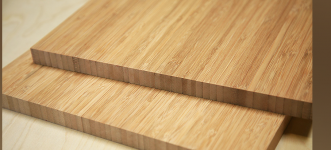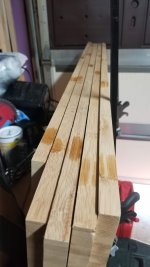I guess Im stubborn, chose a material with an unknown expansion rate. 3/4" Bamboo board. One site says it has alot of movement, another says its pretty stable.
As this is only the outside of the enclosure, I planned on lining the interior with another layer of 3/4" ply or 1/2" MDF.
I know if I simply glue the interior panel to the bamboo, the boo will eventually split from shrinkage. Even if it is stable, I doubt it is as stable as MDF or plywood.
My plan is to run a bead of adhesive down the center of the widest panel on the inside) (its the side panels and 1'3" wide) and leave outer edges of bamboo to more or less slide against the interior panel (that will be cut 1/4" narrower) I was thinking of may be a few dabs of silicone in the corners between the 2 and or may be adding a slot in the interior material and snugging up a screw with washer so there could be a little movement.
Beyond that, Im not 100% sure, has anyone here worked with dissimilar materials and accounted for movement ? Curious how you did it !
As this is only the outside of the enclosure, I planned on lining the interior with another layer of 3/4" ply or 1/2" MDF.
I know if I simply glue the interior panel to the bamboo, the boo will eventually split from shrinkage. Even if it is stable, I doubt it is as stable as MDF or plywood.
My plan is to run a bead of adhesive down the center of the widest panel on the inside) (its the side panels and 1'3" wide) and leave outer edges of bamboo to more or less slide against the interior panel (that will be cut 1/4" narrower) I was thinking of may be a few dabs of silicone in the corners between the 2 and or may be adding a slot in the interior material and snugging up a screw with washer so there could be a little movement.
Beyond that, Im not 100% sure, has anyone here worked with dissimilar materials and accounted for movement ? Curious how you did it !
If it's bamboo plywood, it should be quite stable- a lot of heat, pressure and glue goes into making it.
If it's bamboo plywood, it should be quite stable- a lot of heat, pressure and glue goes into making it.
No, its bamboo board. Strips of bamboo laminated...
Your scheme is a good one and is similar to many construction methods that use a single fastener per board (at any point), but otherwise I'd agree with mlwebb, if it's ply it should be fine.
No, its bamboo board. Strips of bamboo laminated...
All in the same direction or cross laminated through the thickness? If cross laminated treat it as ply.
The laminations should give reasonable resistance to cupping and that kind of movement.
To account for shrinkage I would fasten using mechanical fasteners, over-sizing the holes in either the substrate, the bamboo, or both, the option making sense depending on what fasteners and design you choose. For interior use you should not be needing to account for a great deal of movement. (If that's not the case the board manufacturer needs to look at their QA.)
To account for shrinkage I would fasten using mechanical fasteners, over-sizing the holes in either the substrate, the bamboo, or both, the option making sense depending on what fasteners and design you choose. For interior use you should not be needing to account for a great deal of movement. (If that's not the case the board manufacturer needs to look at their QA.)
Think of the board as a box of straws. The straws won't change dimensions very much in length. Perpendicular to that they will shrink and swell according to how much moisture they contain. And that depends on temperature of the environment. In the winter cold air doesn't contain as much moisture than in the summer when it warms up. Even indoors wood will shrink and swell according to the relative humidity, but obviously not to the extent as if it was subject to the changes outdoors. If you try and constrain the wood from moving it will crack and split. As other posters have said allowing for the movement with holes a bit elongated perpendicular to the direction of the grain is what needs to be done.
holes a bit elongated perpendicular to the direction of the grain
This is true, but in practice it is generally easier to simply drill a bigger hole.
In the winter cold air doesn't contain as much moisture than in the summer when it warms up.
Very location dependent, it's the other way around here.
What you need to know about bamboo | Woodworking Network
Gene Wengert is pretty reliable, prof emeritus in forestry (if I remember correctly). Says stability is close to oak, so probably best to treat it as a solid wood, but less likely to bend, since growth is similar in both axes. along the long axis is negligible, like in wood.
Gene Wengert is pretty reliable, prof emeritus in forestry (if I remember correctly). Says stability is close to oak, so probably best to treat it as a solid wood, but less likely to bend, since growth is similar in both axes. along the long axis is negligible, like in wood.
Laminated wood is considerably more stable than solid wood.
Cold air cannot hold near as much moisture as warm air.
There is nothing new or surprising in either of the above constants.
Cold air cannot hold near as much moisture as warm air.
There is nothing new or surprising in either of the above constants.
Cold air cannot hold near as much moisture as warm air.
Nevertheless, timber here expands in winter with the damper weather and shrinks in summer as the humidity goes down. I promise, I sell timber for a living.
Good link, DPH
That looks like nice bamboo. There different "grades" or quality levels. I would expect that to be quite well behaved.
You need to decide which material is dominant and structural. I would pick the bamboo.
One way would be to build a 4 sided bamboo box - dovetail, box joint, splined mitre, biscuit join etc the corners. For the back panel, inset a panel in a groove (like a cabinet door), do the same with a piece of ply with most of the interior removed, as a front frame for fasteners for a removable front baffle. Then glue, butyl tape, etc whatever interior stiffening, mass, etc inside. You might search the Loudspeakers forum, it wouldn't surprise me if there were a few discussions of box construction, dampening, resonance, stiffening, etc.
Michael
That looks like nice bamboo. There different "grades" or quality levels. I would expect that to be quite well behaved.
You need to decide which material is dominant and structural. I would pick the bamboo.
One way would be to build a 4 sided bamboo box - dovetail, box joint, splined mitre, biscuit join etc the corners. For the back panel, inset a panel in a groove (like a cabinet door), do the same with a piece of ply with most of the interior removed, as a front frame for fasteners for a removable front baffle. Then glue, butyl tape, etc whatever interior stiffening, mass, etc inside. You might search the Loudspeakers forum, it wouldn't surprise me if there were a few discussions of box construction, dampening, resonance, stiffening, etc.
Michael
thevoice, I don't doubt what you say for a second. Here our RH stays between 45 and 70 for the most part regardless of the season so I may be missing what happens in your neck of the woods.
Amazing material the boo.. Amzing and strange at the same time... This weekend I extended the 12" wide panels to 15.5" At glue up, the bamboo acted dry and certainly wicked in the tight-bond as any dry stock usually does.... After clamping, I stood the boards up against the sunny side of my house. Started on the next panel, and before gluing up that one returned to the one that was setting up to scrape the glue off as it was in the rubbery stage... Turned the boards around every 20 min so the sun wasn't beating on only one side, just to be sure I wouldn't get any warping... Thes boards were in the sun, on a 60deg dry day for at least 5 hours....
This morning I puled the clamps off and strange, there were what looks to be damp spots where the clamps were.. Oddly, the material feels dry, acted dry, but there is no other explanation as to how the spots showed up only under the clamps... Came home from work today, some 9 hours later and huh!? What I thought was damp spots are STILL there ??
So... moisture or don't want to think but could it be a chemical ?
I have to dig out my moisture meter, and find what setting I should use for boo, but I feel like Im working with something from another planet...
Strange times indeed!
This morning I puled the clamps off and strange, there were what looks to be damp spots where the clamps were.. Oddly, the material feels dry, acted dry, but there is no other explanation as to how the spots showed up only under the clamps... Came home from work today, some 9 hours later and huh!? What I thought was damp spots are STILL there ??
So... moisture or don't want to think but could it be a chemical ?
I have to dig out my moisture meter, and find what setting I should use for boo, but I feel like Im working with something from another planet...
Strange times indeed!
Attachments
The Australian standard for moisture testing notes:
Neither resistance nor capacitance moisture content meters appear to provide consistent and accurate estimates of moisture content with non-solid products such as engineered wood flooring and bamboo-based flooring.
thevoice, I don't doubt what you say for a second. Here our RH stays between 45 and 70 for the most part regardless of the season so I may be missing what happens in your neck of the woods.
Melbourne is between a desert and a big ocean. Funny humidity swings.
Melbourne Climate
I'm going to be picky here bamboo is not a wood, it is grass, regardless of what others write and say.
There could be a chemical reaction between the bamboo and the iron in your clamps causing the stain. Try it again with scraps and place a wooden block or caul between the bamboo and the clamp face. See if it happens then.
FWIW, I’ve been using small offcuts of laminated bamboo boards similar to photo in AudioFanMan post #6 above as cutting boards and trivets in kitchen for at least 10 years, and while they regularly get wiped down with vinegar/water solution and left to air dry, they’ve yet to warp or delam at glue lines, which is more than can be said for the Boos Block Maple board.
- Home
- Design & Build
- Construction Tips
- wood with dissimilar expansion rate techniques ?


